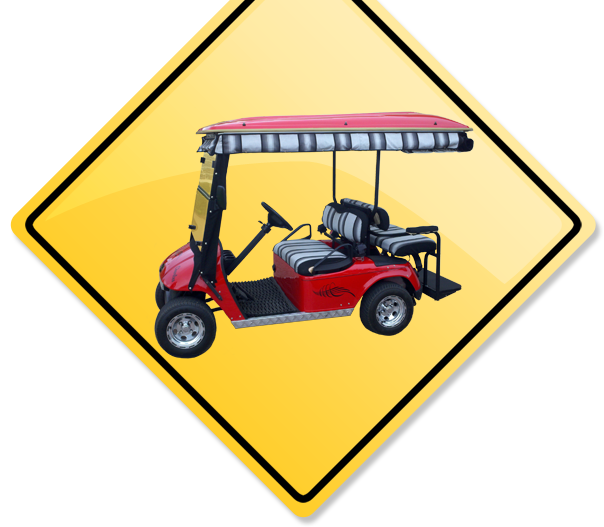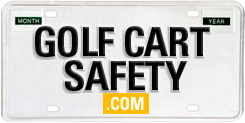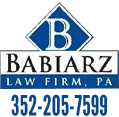

DO I HAVE A CASE?
NEED LEGAL ADVICE?
If you or a loved one has suffered injury in a golf cart accident or golf cart crash, please contact us for a free golf cart accident consultation regarding your legal rights. We have experience litigating and trying cases regarding golf cart crashes and golf cart accidents. We can help.
Questions & Answers
GOLF CARTS
- Where can a golf cart be operated on city streets?
- When can a golf cart be operated?
- How can you decrease risk of passenger ejection and/or rollover injury?
- Are seat belts an option?
- Can I modify my cart for use at a higher speed?
- What are some of the major causes of injury in golf cart incidents?
- Are golf cart brakes like automobile brakes?
- What types of injuries are common in a golf cart incident?
- What is the minimum age to operate a golf cart in The Villages?
- Can you receive a traffic ticket in a golf cart?
- Where can a golf cart/LSV be operated in The Villages?
- How do you safely make a left turn?
LOW SPEED VEHICLES (LSVs)
- What is a Low Speed Vehicle (LSV)?
- Who can operate a low speed vehicle?
- What are licensing requirements for low speed vehicles?
- What are insurance requirements for low speed vehicles?
- What safety equipment is required on a low speed vehicle?
- What is the age limit for operating a Low Speed Vehicle (LSV)?
- Does an LSV have to be registered and insured?
- What is the difference between a golf cart and a Low Speed Vehicle?
- Can you operate a golf cart or LSV at night or in low light?
GOLF CARTS Q&A #1
Where can a golf cart be operated on city streets?
Section 316.212 Fla. Stat. governs time and circumstances under which golf carts can be operated on roadways:
- Can be operated on a state road that has been designed for golf cart use.
- To cross a portion of a county road which intersects a roadway that is approved for golf carts, or that intersects a golf course or mobile home park. In both examples the roadway should have signs posted that golf carts share the roadway.
GOLF CARTS Q&A #2
When can a golf cart be operated?
Florida law states that golf carts can only be operated during the hours between sunrise and sunset, unless night driving is authorized by the local government.
If night driving is allowed, then golf carts must be equipped with headlights, taillights, brake lights, turn signals, and a windshield. The statute also requires the golf cart have efficient brakes, reliable steering, safe tires, a rear view mirror, and reflective warning devices on the front, rear and both sides of the golf cart.
GOLF CARTS Q&A #3
How can you decrease risk of passenger ejection and/or rollover injury?
Avoid sharp turns at high speed. The use of seat belts is also encouraged. Additionally, the use of hand hold bars on either the side of the seat and/or side of the roof can help prevent passenger ejection.
GOLF CARTS Q&A #4
Are seat belts an option?
Yes, although many golf carts are not equipped with seatbelts, it is possible to add seat belts to an existing cart. Check with a qualified dealer or mechanic if your cart does not have a seat belt to have them professionally installed.
GOLF CARTS Q&A #5
Can I modify my cart for use at a higher speed?
Although it is possible to modify a gasoline-powered golf cart through its speed governor to go faster, it is not recommended and is unlawful. By law, golf carts are only allowed to operate at a top speed of 20 mph or less. You could risk a traffic citation for operating a motor vehicle without registration. Additionally, your insurance company might decide to deny paying for damage you cause if you modify your golf cart. Manufacturers generally design golf carts for use at speeds of less than twenty (20) miles per hour. Any additional speed can increase the risk of rollover or vehicle instability, especially during a sharp turn.
GOLF CARTS Q&A #6
What are some of the major causes of injury in golf cart incidents?
In an article entitled “Golf Cart-Related Injuries in the U.S.,” the author Daniel S. Watson identified the following:
- Cart overturn
- Falling/jumping from a moving golf cart
- Collision with another stationary object
- Being hit or run over by a golf cart
- Injury getting into or out of a golf cart; or
- Injury to a protruding limb. 1
GOLF CARTS Q&A #7
Are golf cart brakes like automobile brakes?
Typically, there are some differences. Golf carts ordinarily have brakes only on the rear wheels. As K. J. Seluga noted in the article "Braking Hazards of Golf Carts and Low Speed Vehicles,"2 "Rear wheel only brake designs lead to rear tire skidding and reduce your stability, creating the potential for a cart to easily “fishtail” when the brakes are applied hard. Furthermore, the reduced effectiveness of the brakes on a downhill slope can lead the cart driver to falsely perceive a brake failure, causing him to press harder on the brake pedal leading to a locking of the braked wheels and an out of control skid."
GOLF CARTS Q&A #8
What types of injuries are common in a golf cart incident?
The most common injuries involve sprains and strains which often require medical attention. Fractures of the extremities (arms and hands, legs and feet) are also common, as are lacerations (cuts). Less common, but even more serious are head injuries, especially involving loss of consciousness and/or subdural bleeding, spinal cord injury or acute respiratory injury. The most serious injuries often involve vehicle rollover incidents. See Watson, Daniel S. et al. “Golf Cart Related Injuries in the U.S.” American Journal of Preventive Medicine 35 (2009): 55–59; and Kelly, E. G. “Major Injuries Occurring During Use of a Golf Cart,” South Hill Orthopaedic Surgery Associates, Pittsburg, 1996. 519-21.
GOLF CARTS Q&A #9
What is the minimum age to operate a golf cart in The Villages?
Drivers must be at least 14 years of age under Florida law. 3 Therefore, a golf cart driver is not required by Florida law to be a licensed driver, but it is nonetheless a good idea. In addition to being of age, drivers are also charged with knowing the rules of the road.
GOLF CARTS Q&A #10
Can you receive a traffic ticket in a golf cart?
Yes, traffic laws apply to golf carts in much the same way as they do to automobiles. For example, you can get the same driving under the influence (DUI) citation under Section 316.193, Fla. Stat. The golf cart driver also can be cited for other traffic violations, such as running a stop sign or failure to yield, etc. These citations can result in fines and points against your license.
GOLF CARTS Q&A #11
Where can a golf cart/LSV be operated in The Villages?
The following information is provided by The Villages Homeowners’ Association in its brochure entitled “Golf Cart and Low Speed Vehicle Safety Guidelines In and Around The Villages”:
The Rules of the Road:
Golf carts may not cross over or drive on Highway 27/441, CR 466, CR 466A, Griffin Avenue or any other road with a posted speed limit of 35 mph or higher. LSVs can be operated on a road whose speed limit is 35 mph or less. A golf cart can be operated on a state road that has been designated and marked for golf cart use.
Golf carts must use the transportation multi-modal trails adjacent to El Camino Real, Buena Vista Boulevard, Morse Boulevard and CR 466 & CR 466A. These roadways can only be crossed in a golf cart by using the marked tunnels. The only exceptions are that golf carts can cross El Camino Real at the traffic light between Enrique Drive and Botello Avenue. In addition, while golf carts are not permitted to travel on Rainey Trail (CR 472) they are permitted to cross between Lynnhaven and Miona Shores Drive. LSVs are permitted to travel on Rainey Trail since the speed limit is 35 mph.
On Streets within The Villages, with a posted speed limit of 30 mph or less, golf carts should be driven in the marked diamond lanes or along the right-hand edge of the street if there is no marked lane.
These guidelines are provided by the Villages Homeowners Association (VHA) for information purposes only and to help you enjoy using a golf cart and to help keep you and your loved ones safe. Please remember that your golf cart was not designed to share a roadway with larger vehicles such as cars or trucks. In the event of a collision you have about as much protection as if you were riding a motorcycle.
A golf cart is defined as a motor vehicle that is designed for operation on a golf course or for sporting or recreation and is not capable of exceeding 20 mph. While the operator of a golf cart does not have to be a licensed driver, the driver must be over 14 years of age.
A LSV is defined as a four-wheel electric vehicle whose top speed is greater than 20 mph, but less than 25 mph. LSVs may operate on streets where the posted limit is 35 mph or less. LSVs can also cross roads that have a speed limit greater than 35 mph.
The National Highway Transportation Safety Administration (NHTSA) and FMVSS standards for LSVs require headlights, taillights, front and rear turn signals, stop lights, reflex reflectors, driver’s side mirror and a passenger side rear view mirror or interior rear view mirror, parking brake, windshield, a VIN number and seatbelts. 4
Under Florida law, Section 316.212 Fla. Stat. allows golf carts to be operated on public roads only if the roads are designated for use by golf carts. Further, golf carts cannot be operated by persons under fourteen (14) years of age.
LSV use in Florida on public roads is governed by Section 316.2122, Fla. Stat. This section does not require any designation of the road for use by LSVs. However, LSVs may only be operated on roadways with a posted speed of less than 35 mph. LSV operators must have a valid driver’s license and the LSV must be licensed and insured pursuant to Section 320.02, Fla. Stat.
GOLF CARTS Q&A #12
How do you safely make a left turn?
The Villages Homeowners Association’s Safety Guidelines suggest:
When making a left turn, after signaling your intention, carefully merge with vehicular traffic just prior to the intersection and turn using the proper signal and turn lane where available. If signage or road markings provide such direction golf cart traffic should also merge with vehicular traffic. Golf carts should yield to other vehicular traffic in all cases.
LOW SPEED VEHICLES (LSVs) Q&A #1
What is a Low Speed Vehicle (LSV)?
Low Speed Vehicle is defined as a four wheeled electric vehicle whose top speed is greater than 20 mph, but less than 25 mph.
Section 316.2122 Fla. Stat. states that a low speed vehicle may operate on streets where the posted speed limit is 35 mph or less. The vehicle can also cross intersecting roadways where the speed is greater than 35 mph.
LOW SPEED VEHICLES (LSVs) Q&A #2
Who can operate a low speed vehicle?
The operator of a low speed vehicle must be a licensed driver.
LOW SPEED VEHICLES (LSVs) Q&A #3
What are licensing requirements for low speed vehicles?
A low speed vehicle must have a registered license plate.
LOW SPEED VEHICLES (LSVs) Q&A #4
What are insurance requirements for low speed vehicles?
In addition to having a valid license plate and registration, a LSV must be insured. Florida law requires PIP or No-Fault coverage at a minimum. We strongly recommend Bodily Injury (BI), Uninsured Motorist (UM), and Medical Payments (MedPay) coverages. See our article on Insurance For Golf Carts and Low Speed Vehicles in this website.
LOW SPEED VEHICLES (LSVs) Q&A #5
What safety equipment is required on a low speed vehicle?
Any low speed vehicle must be equipped with standard safety equipment.
NHTSA requires these components: headlights, taillights, stoplights, front and rear turn signals, reflectors, parking brakes, rearview mirrors, windshields, safety belts, and vehicle identification numbers. Significantly, NHTSA does not require LSVs to have airbags, or other safety features beyond seatbelts since they are intended for low risk driving.
LOW SPEED VEHICLES (LSVs) Q&A #6
What is the age limit for operating a Low Speed Vehicle (LSV)?
The operator of an LSV must be a licensed driver (At least 16 years old in Florida).
LOW SPEED VEHICLES (LSVs) Q&A #7
Does an LSV have to be registered and insured?
Yes, an LSV must have a registered license plate and must be insured.
LOW SPEED VEHICLES (LSVs) Q&A #8
What is the difference between a golf cart and a Low Speed Vehicle?
Primarily, a golf cart is designed with a top speed of twenty miles per hour or less, while a Low Speed Vehicle is defined as a four wheeled electric vehicle whose top speed is greater than 20 mph, but less than 25 mph. Golf carts that can go over 20 mph because of their original equipment or due to post-sale modifications are considered LSVs.
LOW SPEED VEHICLES (LSVs) Q&A #9
Can you operate a golf cart or LSV at night or in low light?
To operate a golf cart or LSV at night or in low light, your golf cart or LSV must be equipped with headlights, brake lights, turn signals and reflective warning devices on the front and rear side of the vehicle. Headlights are recommended between 30 minutes before sunset and 30 minutes after sunrise and should be used in inclement weather and other low light conditions. 5
- 1 “Golf Cart-Related Injuries in the U.S., ” Daniel S. Watson, American Journal of Preventive Medicine, 2008; Volume 35, Issue 1, P. 55-59, July, 2008.
- 2 “Braking Hazards of Golf Cars and Low Speed Vehicles,” K. J. Seluga, Accident Analysis & Prevention, Volume 38, Issue 6, November, 2006, pages 1151-1156.
- 3 Section 316.212 (7), Fla. Stat.
- 4 Federal Motor Vehicle Safety Standards (FMVSS) 571.500.
- 5 Section 316.212 (5), Fla. Stat.


